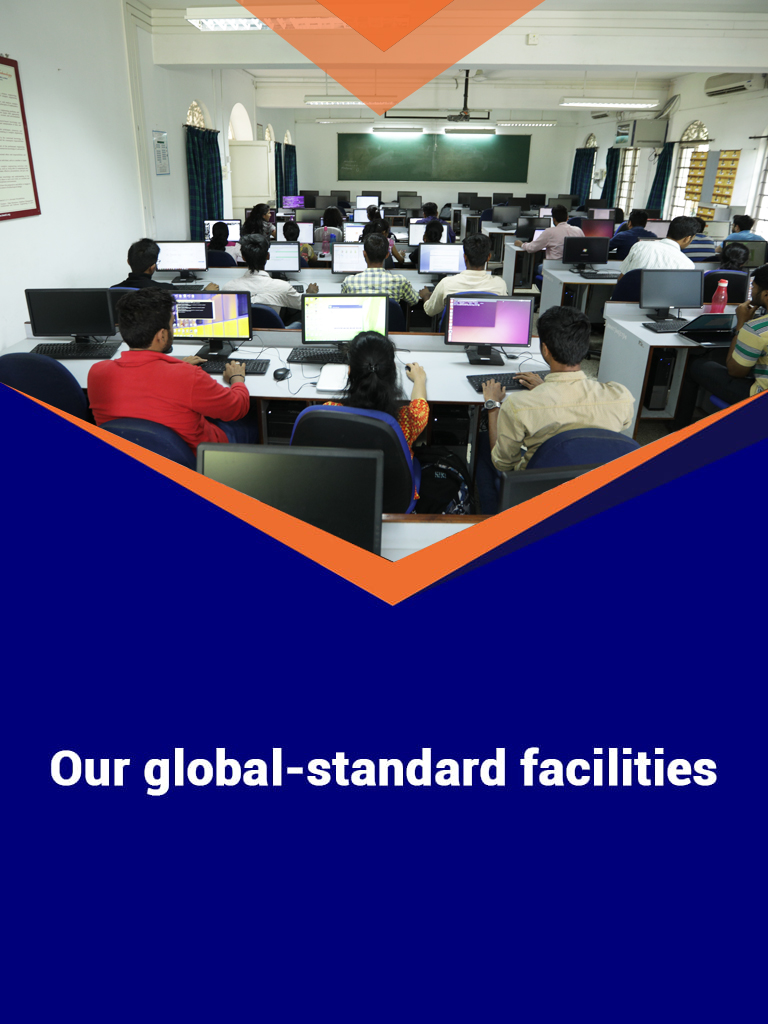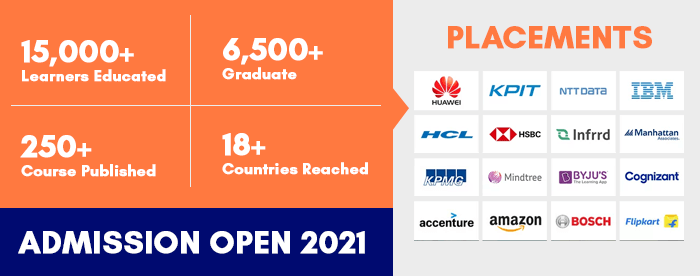LABORATORY INFORMATION
The Department of Artificial Intelligence & Machine Learning (AIML) started very recently with an exciting journey in the year 2020 and its first batch of students who will be entering to 2nd year of the AIML B.E program during the academic year 2021-22, hence the department currently equips with four laboratories to cater the needs of the teaching-learning process. The other laboratories that are required during the next two academic years and beyond the curriculum are planned to be ready in the near future including the following:
- Creation of Artificial Intelligence Labs and Research centers for stimulating AI and ML Research & Innovation using NVIDIA Server facilities.
- Create the state-of-the-art infrastructure, namely reaction speed (latency), data speed, and reliability for effective AI and ML applications.
- Creation of hacker/maker spaces available to students to discuss their out-of-the-box ideas and potential start-up ventures.
- Creation of Active-learning laboratories and to carry out quality real-world projects.
- Collaborate with industry to start and sustain industry-powered laboratories.
- Providing excellent training opportunities to students for skill-development programs.
All the laboratories are equipped with state-of-the-art infrastructure with the latest computer machines/equipment with high-end configurations running on Windows as well as Linux platforms. Every computer system has access to broadband internet connectivity. This provides an excellent learning platform for students, faculty, and researchers. Students have exclusive one-to-one computing facilities through well-furnished separate Labs with all the required software. Following are the laboratories for AIML students during their 2nd year of study.
Data Structures Lab
Data Structures and Applications Lab course provides the fundamentals and foundations for students to get competent enough in their higher semesters and in their professional careers. Learning and applying the data structure concepts demands a great amount of analytical and logical thinking skills in various software applications. The laboratory experiments are designed in increasing order of complexity levels of the course and the benefits of adopting such a structured design, students would learn concepts in incremental order which helps faculty to identify intellectual levels at which individual students are capable of learning, and develops high-level thinking skills. Thus, the students will be able to:
- Acquire the fundamental knowledge of various types of data structures and pointers and design the programs using pointers.
- Apply the fundamental programming knowledge of data structures such as stacks, queues and use them for solving problems.
- Design various functions for implementation of singly-linked lists, circular linked lists, and doubly-linked lists.
- Implement and apply the concept of binary trees and binary search tree data structures.
- The case study experiments in understanding the need and working of Data Structures used in real-time applications.
Design & Analysis of Algorithms Lab
The objective of the Design & Analysis of Algorithms Lab is to build a strong foundation in designing algorithms and their efficiency. The students will learn to analyze the algorithms and to represent the efficiency of these algorithms in terms of the standard asymptotic notations, devise the various algorithm techniques (such as brute-force, greedy, dynamic programming, etc.), and apply these methods in designing algorithms to solve a given problem. Thus, the students will be able to:
- Develop and implement an algorithm to demonstrate its performance using brute-force, divide-and-conquer paradigms. For the given algorithm, develop the recurrence; Analyze and Simplify the recurrence to obtain the performance of the divide-and-conquer algorithm.
- Develop and implement an algorithm and demonstrate the shortest-path, Travelling Sales Person problem and minimum spanning tree problems and its performance using greedy technique and dynamic-programming paradigms.
- Describe the Backtracking, Branch, and Bound algorithm design paradigms and explain when an algorithmic design situation calls for it. Relate algorithms that employ these paradigms. Develop and implement the Backtracking algorithms and demonstrate their performance.
- The case study experiments in understanding the need and working of Algorithms used in real-time applications.
Microcontroller and Embedded Systems Laboratory
The objective of Microcontroller and Embedded Systems Laboratory is to design, develop and execute the experiments by writing programs using ARM7TDMI / LPC2148 using an evaluation board/simulator and the required software tool and also evaluation board using the evaluation version of Embedded ‘C’ & Keil Uvision-4 tool/compiler. The students will be able to:
- Develop and test programs using ARM7TDMI / LPC2148.
- Conduct experiments on an ARM7TDMI / LPC2148 evaluation board using the evaluation version of Embedded ‘C’ & Keil Uvision-4 tool/compiler.
DBMS Laboratory with Mini Project
This is a core course of Artificial Intelligence and Machine Learning branch that provides a strong foundation in database concepts, technology. Students will be able to practice SQL programming through a variety of database problems and demonstrate the use of concurrency and transactions in database. They can design and build database applications for real world problems. Thus, Students will be able to:
- Understand the concept of structured and un-structured database, functional dependencies and transaction processing.
- Apply Structured Query Language (SQL) for database
- Apply Functional Dependency to normalize
- Solve the real time problem by using NOSQL
- Develop application to interact with
Python Programming and Applications
Python Lab enables students to learn and practice basic python programming. Students can expand their skillset by learning and solving basic problems in python. Python is very easy to use, powerful, and versatile. In this lab students will acquire knowledge to solve problems in various domains using different tools. They will also develop the ability to write database applications and perform file handling, exception handling using Python. Upon completing this course students will be able to
- Demonstrate proficiency in handling of loops and creation of functions.
- Identify the methods to create and manipulate lists, tuples and dictionaries.
- Discover the commonly used operations involving regular expressions and file system.
- Interpret the concepts of Object-Oriented Programming as used in Python.
- Determine the need for scraping websites and working with PDF, JSON and other file formats.
Machine Learning Laboratory
Machine Learning Laboratory provides students of all semesters all the required software and hardware infrastructure to learn, experiment and performing analysis with Machine Learning algorithms, build Machine Learning models, evaluate their performance, and apply them appropriately to a given problem. Through these exercise students enhance their analytics and logical skills. There are 4 laboratories having 138 desktop computers with the latest specifications such as 12th Gen. Intel i7 Processor with 16 GB of Memory each installed with Windows 11 and Linux Operating System along with Anaconda Data Science Platform. Thus, students should be able to
- Use standard tools and technologies related to machine learning
- Learn, implement and demonstrate Machine Learning algorithms and techniques
- Analyze and evaluate the performance of different Machine Learning algorithms
- Apply Machine Learning algorithms effectively to appropriate applications
Digital Image Processing Laboratory
This course will enable students understand the fundamentals of digital image processing, image transform, image enhancement techniques, image restoration techniques and methods and Morphological Operations and Segmentation used in digital image processing. Additionally, students will understand, Ascertain and describe the basics of image processing concepts through mathematical interpretation. Students will be able to apply image processing techniques in both the spatial and frequency (Fourier)domains. Students will be able to demonstrate image restoration process and its respective filters required. They will be able to design image analysis techniques in the form of image segmentation and to evaluate the Methodologies for segmentation. They can Conduct independent study and analysis of Image Enhancement techniques. Students can demonstrate the basic skills of image process. They can demonstrate the application development skills and lastly Design and develop the applications of images.
Artificial Intelligence Laboratory
This course enabled students to Implement and evaluate AI algorithms in Python programming language. They become familiar with basic principles of AI toward problem solving. Get to know approaches of inference, perception, knowledge representation, and learning. Students will be Able to Apply the knowledge of Artificial Intelligence to write simple algorithm for agents. Apply the AI knowledge to solve problem on search algorithm. Develop knowledge base sentences using propositional logic and first order logic. Apply first order logic to solve knowledge engineering process.
Innovative Project Lab (IPL)
The goal of IPL is to devise novel ideas. Creative processes like design thinking and many more can drive ideation and the development of new innovations. IPL is tasked with coming up with new ideas, executing them, and iterating until the idea is fully executed or integrated into the business. This lab helps attract and retain talent from younger workforce who increasingly want to work for forward-thinking, fast-paced companies. In BNMIT, every student is involved in doing Innovative projects every semester under their respective guides. These projects under IPL include software as well as hardware projects.



